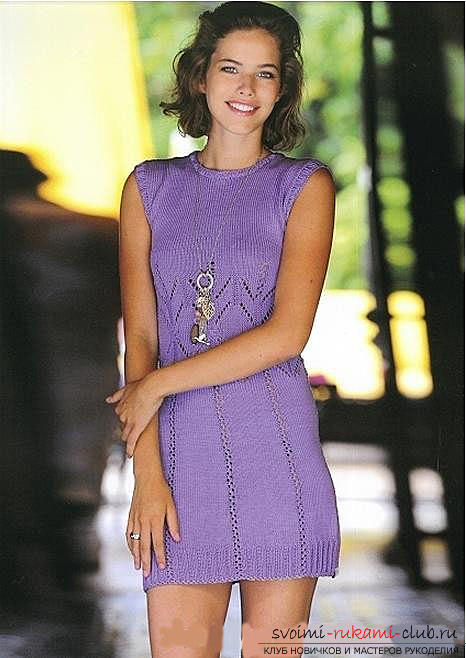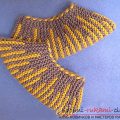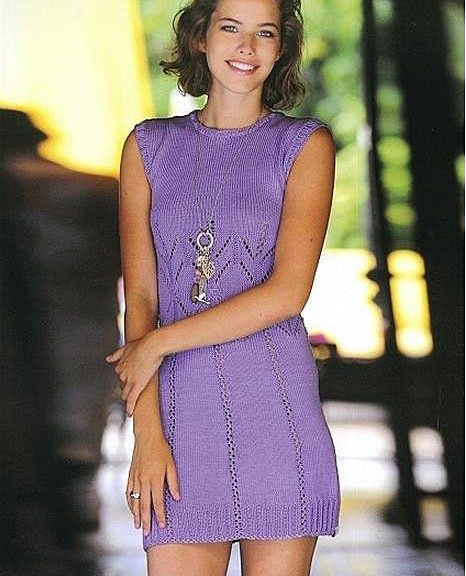
We knit a model of mini-dresses with spokes spring 2015 for a young girl with description and schemes for free
We knit with knitting a fashionable mini dress In this article wewe offer you a detailed description of the knitting of the youth short dress, which will be very useful for the springtime. The data given are for a size of thirty-four / thirty-six. Information in brackets is for a larger size - forty / forty-two. In the case that only one numerical value is represented, it means that it is suitable for all sizes.  If only one value is specified, itapplies to both sizes. The length of the model of our dress is within eighty-two (eighty-three and a half) centimeters. To connect such an easy and short youth dress, you will need: four hundred and fifty (five hundred) grams of lilac yarn Line 11 Alfa brand online (number of yarn - fifty-two); the main knitting needles are circular # 3,5, and auxiliary knitting needles are also needed. We advise that it is not necessary to use short circular needles to create an armhole and throat bar. You can use stocking knitting needles or circular, but longer. The basic patterns: "elastic" (alternately create 2 face loops, 2 purl). Facial smoothness in circular rows: all eyelets are tied with facial.
If only one value is specified, itapplies to both sizes. The length of the model of our dress is within eighty-two (eighty-three and a half) centimeters. To connect such an easy and short youth dress, you will need: four hundred and fifty (five hundred) grams of lilac yarn Line 11 Alfa brand online (number of yarn - fifty-two); the main knitting needles are circular # 3,5, and auxiliary knitting needles are also needed. We advise that it is not necessary to use short circular needles to create an armhole and throat bar. You can use stocking knitting needles or circular, but longer. The basic patterns: "elastic" (alternately create 2 face loops, 2 purl). Facial smoothness in circular rows: all eyelets are tied with facial.  Facial smoothness in ordinary rows: The front rows are created with the help of the front loops, the back rows are knit with the use of the back loops. Openwork pattern: we knit the number of loops, which is a multiple of twenty. We create in circular rows, following the scheme. In all the second circular rows (which are not shown), the loops are made, following the pattern, the nakids are created by the facial. Determine the density of the mating: At the face of the face: twenty-one loops and thirty-one rows / circular rows correspond to the dimensions of the cloth ten by ten centimeters. When creating an openwork pattern, the density of knitting will vary: twenty-three loops and thirty-one rows / circular rows correspond to the dimensions of the fabric ten by ten centimeters.
Facial smoothness in ordinary rows: The front rows are created with the help of the front loops, the back rows are knit with the use of the back loops. Openwork pattern: we knit the number of loops, which is a multiple of twenty. We create in circular rows, following the scheme. In all the second circular rows (which are not shown), the loops are made, following the pattern, the nakids are created by the facial. Determine the density of the mating: At the face of the face: twenty-one loops and thirty-one rows / circular rows correspond to the dimensions of the cloth ten by ten centimeters. When creating an openwork pattern, the density of knitting will vary: twenty-three loops and thirty-one rows / circular rows correspond to the dimensions of the fabric ten by ten centimeters. 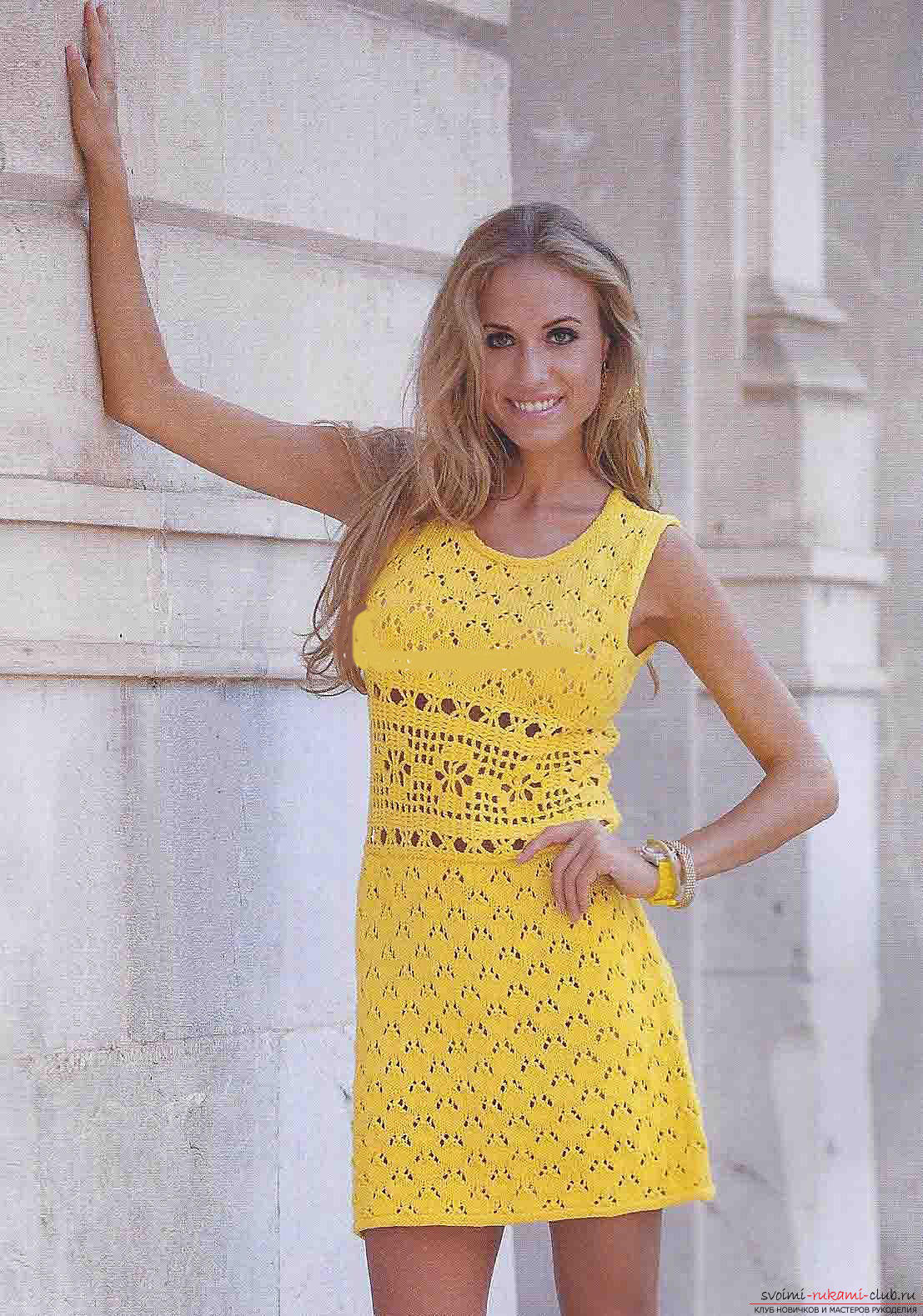 Circular ranks are used in creating a dress upsleeve armhole. We make a set of loops in a cross way. In total, you need to dial two hundred and twenty-four (two hundred and fifty-two) loops. Next, we make a closure in the circle of work and create one circular series of facial loops. After that, we continue to work using a pattern of "rubber band" with openwork strips, focusing on the scheme (only eight (nine) rapports). Having knitted six and a half centimeters (or twenty circular rows), the "elastic" knit with the front surface, the strip from the openwork pattern is also continued. To create skew skirts, you need to knit two loops together with a facial broach through twenty circular rows from the "gum" (after all the lace strips). In doing so, we remove one loop as a front one, make one face loop and loop it through the removed loop. The result is two hundred and sixteen (two hundred and forty-three) loops. Having made ten subsequent circular rows in front of all stripes of openwork pattern, we knit together two eye loops (total, two hundred and eight (two hundred thirty four) loops).
Circular ranks are used in creating a dress upsleeve armhole. We make a set of loops in a cross way. In total, you need to dial two hundred and twenty-four (two hundred and fifty-two) loops. Next, we make a closure in the circle of work and create one circular series of facial loops. After that, we continue to work using a pattern of "rubber band" with openwork strips, focusing on the scheme (only eight (nine) rapports). Having knitted six and a half centimeters (or twenty circular rows), the "elastic" knit with the front surface, the strip from the openwork pattern is also continued. To create skew skirts, you need to knit two loops together with a facial broach through twenty circular rows from the "gum" (after all the lace strips). In doing so, we remove one loop as a front one, make one face loop and loop it through the removed loop. The result is two hundred and sixteen (two hundred and forty-three) loops. Having made ten subsequent circular rows in front of all stripes of openwork pattern, we knit together two eye loops (total, two hundred and eight (two hundred thirty four) loops). 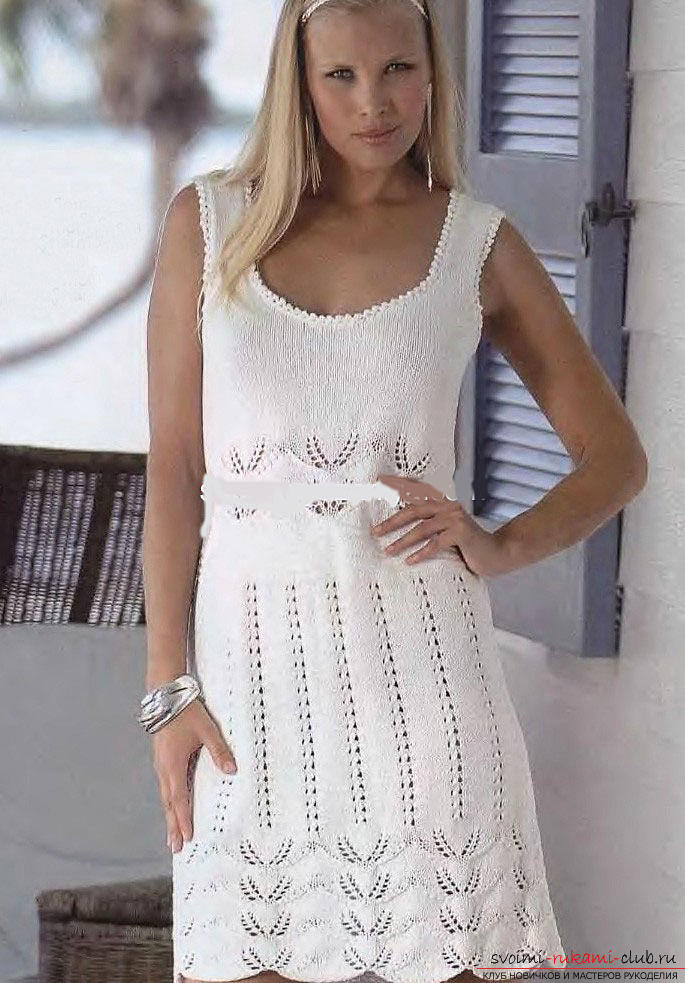 Similar dilutions are carried out in all tenthscircular rows in front of openwork strips (as a result - one hundred sixty (one hundred and eighty) loops). After making thirty-two centimeters from the "gum", make 1 * from the first to the sixty-fourth circular rows, following the pattern of the lace pattern. The further execution of the dress is carried out with the help of the main pattern. For a sleeve armhole, after fifty-seven centimeters from the "rubber band" pattern, the knitting that is on the transitional circular row should be divided into two parts (eighty (ninety) loops) in the center and subsequently carried out separately. Note: when knitting for a size of thirty-four / thirty-six loops you need to separate from the most circular junction, but for the size of forty / forty-two you need to tie another five loops, and only then continue to work with the front and back separately to ninety loops . As a result, you see that the pattern is symmetrical. In addition to the eighty (ninety) loops of the back, it is necessary to tie another nineteen (twenty and a half) centimeters with straight rows. After that, in order to make a cutout for the neck, you need to close thirty loops in the middle. From two sides make twenty-five (thirty) shoulder loops. The front part is done similarly, however, for the neck, after tying thirteen (fourteen and a half) centimeters from the armhole arm, it is necessary to close the central twenty loops and complete the two sides separately.
Similar dilutions are carried out in all tenthscircular rows in front of openwork strips (as a result - one hundred sixty (one hundred and eighty) loops). After making thirty-two centimeters from the "gum", make 1 * from the first to the sixty-fourth circular rows, following the pattern of the lace pattern. The further execution of the dress is carried out with the help of the main pattern. For a sleeve armhole, after fifty-seven centimeters from the "rubber band" pattern, the knitting that is on the transitional circular row should be divided into two parts (eighty (ninety) loops) in the center and subsequently carried out separately. Note: when knitting for a size of thirty-four / thirty-six loops you need to separate from the most circular junction, but for the size of forty / forty-two you need to tie another five loops, and only then continue to work with the front and back separately to ninety loops . As a result, you see that the pattern is symmetrical. In addition to the eighty (ninety) loops of the back, it is necessary to tie another nineteen (twenty and a half) centimeters with straight rows. After that, in order to make a cutout for the neck, you need to close thirty loops in the middle. From two sides make twenty-five (thirty) shoulder loops. The front part is done similarly, however, for the neck, after tying thirteen (fourteen and a half) centimeters from the armhole arm, it is necessary to close the central twenty loops and complete the two sides separately.  To make the rounding of the neck, it is necessaryall the second rows of tying five loops of one. Having drawn nineteen (twenty and a half) centimeters from the sleeve armhole, twenty-five (thirty) shoulder loops should be made. We assemble the parts of the product: We make seams on the shoulders, using knitted or the stitch seam. For the manufacture of the throat bar, it is necessary to make an eighty-four loops rise and connect four circular rows with the rubber band pattern, and then make a loop closure following the pattern. To make the hose strip, it is necessary to make an eighty-three loops rise (ninety-one), starting from the marking * on the diagram. We knit a pattern of "elastic": one face, then follows a repeating part of the picture: two purlins, two facial loops. We finish with two wrong loops. In all the second circular rows on the first loop we knit three loops together with one face broach. This loop should be removed together with the previous loop as a facial, the subsequent loop made facial and held through two loops removed. After six circular rows, the loops are closed, following the pattern.
To make the rounding of the neck, it is necessaryall the second rows of tying five loops of one. Having drawn nineteen (twenty and a half) centimeters from the sleeve armhole, twenty-five (thirty) shoulder loops should be made. We assemble the parts of the product: We make seams on the shoulders, using knitted or the stitch seam. For the manufacture of the throat bar, it is necessary to make an eighty-four loops rise and connect four circular rows with the rubber band pattern, and then make a loop closure following the pattern. To make the hose strip, it is necessary to make an eighty-three loops rise (ninety-one), starting from the marking * on the diagram. We knit a pattern of "elastic": one face, then follows a repeating part of the picture: two purlins, two facial loops. We finish with two wrong loops. In all the second circular rows on the first loop we knit three loops together with one face broach. This loop should be removed together with the previous loop as a facial, the subsequent loop made facial and held through two loops removed. After six circular rows, the loops are closed, following the pattern. 